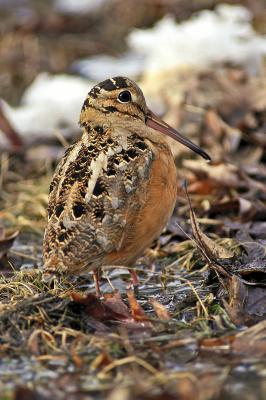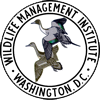


The American woodcock (Scolopax minor), also called the timberdoodle, lives in young forest and shrubby areas often near streams, rivers, and wetlands. Woodcock eat worms, which they catch by probing in the soil with their long bills. They breed across eastern North America from Atlantic Canada to the Great Lakes, and spend the winter in lowlands mainly in the southern and Gulf Coast states.
In the past, woodcock were abundant because plenty of young forest – also called "early successional habitat" – existed in their range. But many brushy areas have grown into mature forest, where woodcock do not live. And human development has destroyed much of the birds' former habitat. Because of these factors, the species' population has fallen by about 1 percent each year since the 1960s.
What can be done to reverse this trend -- to make sure that the woodcock, beloved by outdoor enthusiasts and an important member of our continent’s diverse wildlife, continues to thrive?
-- to make sure that the woodcock, beloved by outdoor enthusiasts and an important member of our continent’s diverse wildlife, continues to thrive?
A bold new effort has begun to restore and expand the places where woodcock can live. In 2001, many federal and state wildlife agencies, along with organizations including the Wildlife Management Institute, the Association of Fish and Wildlife Agencies, and the Ruffed Grouse Society, formed the Woodcock Task Force.
Since then, using funding from the National Fish and Wildlife Foundation and administered by the Wildlife Management Institute, biologists and land managers have developed a Woodcock Conservation Plan (pdf). The Plan sets targets for woodcock populations and acres of habitat to be created and restored in the United States and Canada.
To implement the Plan, managers have set up regional habitat initiatives based on Bird Conservation Regions developed by NABCI, the North American Bird Conservation Initiative. Regional initiatives depend on partnerships between agencies, organizations, forest products companies, and individuals in different parts of the woodcock's range.
Partners work together to create healthy, productive tracts of young forest through logging, planting native shrubs and trees, controlled burning, and other habitat-management techniques -- efforts that help woodcock, along with many other wild creatures including birds such as golden-winged warblers, brown thrashers, and whip-poor-wills; mammals including bobcats and cottontail rabbits; and reptiles like bog turtles and wood turtles.
Carefully designed Science underpins this rangewide habitat-creation endeavor.
Explore this website to learn more about woodcock, the plan for their recovery, and how to improve and create habitat for timberdoodles and the other wild animals with which they share the landscape.

© 2012 A Wildlife Management Institute Project